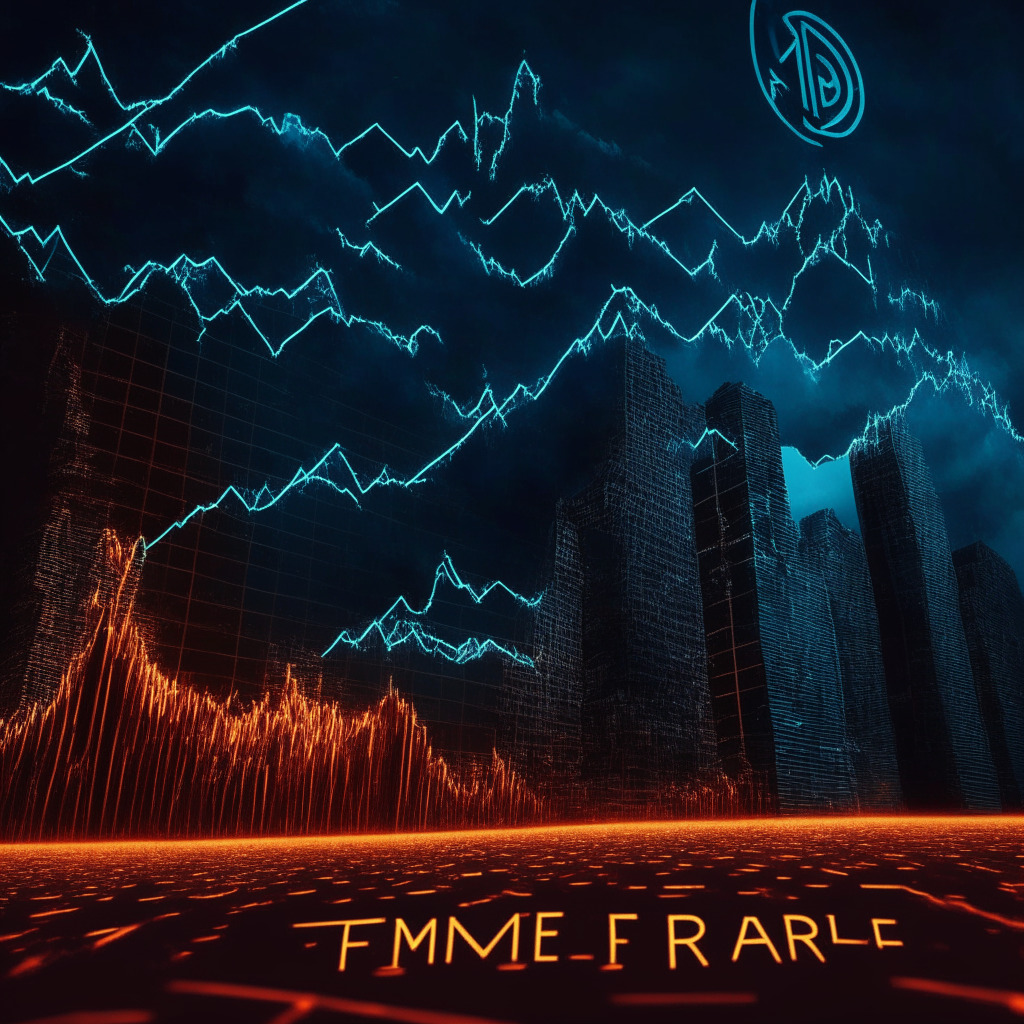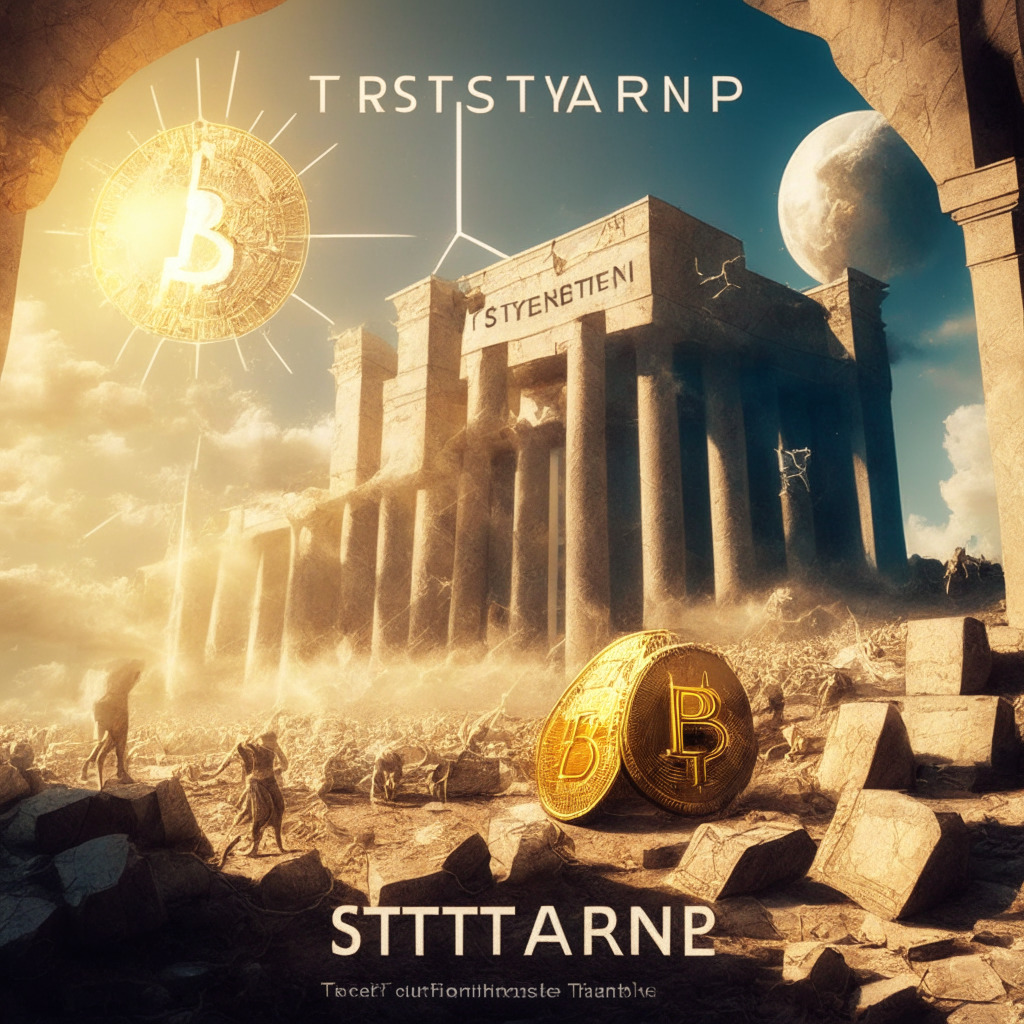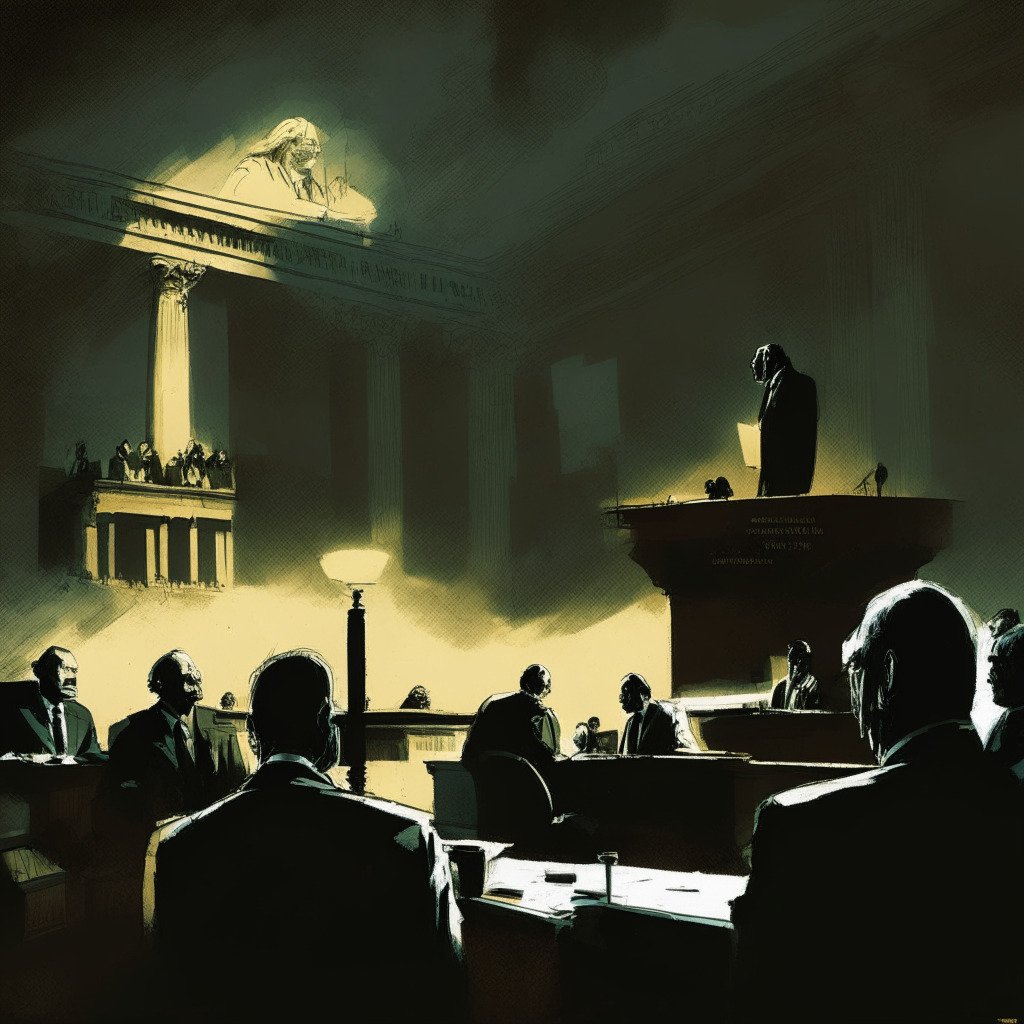Newly disclosed documents reveal that Tether Holdings Ltd., issuer of the largest stablecoin USDT, previously held reserves in Chinese company-issued securities, short-term loans to Chinese companies, and a loan to crypto platform Celsius Network. Concerns arise over Tether’s $5.1 billion lending program, underpinning USDT’s importance for liquidity and stability in cryptocurrency markets.
Search Results for: Trust Reserve
Bitcoin’s Rocky Road to Recovery: Blackrock’s ETF Filing and The Future of Crypto Markets
The cryptocurrency market shows signs of recovery with Bitcoin bouncing back to $25,500, driven by factors such as Blackrock’s filing for a spot Bitcoin ETF and oversold conditions. However, caution and vigilance are essential as the market navigates uncertain conditions and ongoing regulatory disputes.
Bitcoin’s Struggle to Find Support above $24k amidst Economic Turbulence & Miami Mayor’s Crypto Plans
The recent 5% drop in Bitcoin’s price raises concerns about market stability and the crucial $24,000 support level. This follows a hawkish statement from the Federal Reserve and a turbulent week for cryptocurrencies, with the next support level at $24,350.
Crypto Volatility Persists: FOMC Pause, SEC Charges, and Future Rate Hikes
The crypto market remains volatile following the June 14 FOMC announcement pausing rate hikes, affecting Bitcoin price. Muted crypto price action potentially reflects lingering effects of SEC charges against Binance and Coinbase. While interest rate hikes are paused, regulation remains a major threat, with SEC enforcement actions increasing and investor sentiment remaining low.
Binance vs SEC: Potential Settlement Paves Way for Crypto Industry Future
In a recent hearing, U.S. District Judge Amy Berman Jackson declined the SEC’s request to freeze Binance’s US arm assets, leading experts to suggest a possible settlement. The federal judge requested a mediation hearing, raising questions about the SEC’s approach towards the crypto industry. The case’s outcome could have broader implications for the relationship between crypto exchanges and regulatory authorities.
MakerDAO’s GUSD Dilemma: Balancing Capital Efficiency and Stability in DeFi
MakerDAO’s community is voting on a proposal to reduce GUSD holdings in its DAI stablecoin reserve from $500 million to $110 million. The decision weighs better capital efficiency and revenue opportunities against potential risks linked to decreased GUSD exposure, impacting the future of MakerDAO and stablecoin investments in DeFi.
Digital Dollar: Evaluating CBDC Benefits, Risks, and Privacy Concerns in the Financial Landscape
The US Treasury explores the potential of a central bank digital currency (CBDC) for improving payment efficiency and financial inclusion. However, risks, privacy concerns, and design decisions could impact benefits. Careful design and implementation are crucial for the digital dollar’s future.
Debunking BNB Price Manipulation Rumors: Binance CEO Clears the Air
Binance CEO CZ Zhao refutes rumors that the crypto exchange has been offloading Bitcoin to maintain BNB prices, stating they’ve neither sold BTC nor BNB. The allegations by Crypto Twitter users led to debate, but CoinGecko data shows a positive trend for BNB and minimal declines for BTC. Transparency and reliable information are essential in the highly speculative crypto community.
Binance’s Mounting Troubles: SEC Charges, TUSD Minting Pause, and Massive Liquidations
Binance faces mounting troubles as TrueUSD (TUSD) minting via Prime Trust is paused, adding to the exchange’s woes after the SEC brought 13 charges against them. Despite this, TUSD ensures users that minting and redemption services will continue without disruption. Meanwhile, the crypto market experiences a massive liquidation amid unfavorable conditions.
India’s Digital Rupee: CBDC Revolution or Privacy Concerns? Pros and Cons Explored
The Reserve Bank of India (RBI) progresses towards implementing the Digital Rupee, a central bank digital currency (CBDC), aiming to onboard one million users. RBI’s pilot program expands, promoting interoperability between CBDC QR codes and India’s Unified Payments Interface. Challenges like privacy and data security must be addressed to maintain trust.
Bipartisan Stablecoin Regulations: Growth Catalyst or Innovation Stifler?
The House Financial Services Committee’s new draft legislative proposal for stablecoin regulations in the U.S. aims to establish bipartisan consensus. This legislation could bring clarity to the crypto market, however, concerns about increased oversight hindering innovation arise. Democrats’ stance on the current version remains unclear.
Silvergate Collapse: A Wake-Up Call for Crypto-Friendly Banking? Lessons & Future Implications
The recent collapse of crypto-friendly bank Silvergate has raised regulatory concerns and may serve as a wake-up call for the crypto community. The event highlights the need for a cautious approach when investing in digital currencies and the importance of market stability.
Hong Kong’s First Digital USD Stablecoin: Stability Meets Programmability on BNB Chain
Hong Kong-based First Digital Group introduces its First Digital USD (FDUSD) stablecoin on the BNB Smart Chain, offering programmable abilities for executing contracts, escrow services, and insurance without intermediaries. Regulated under the Hong Kong Trustee Ordinance, FDUSD is backed by US dollar reserves or high-quality assets, ensuring stability and regulatory compliance.
MakerDAO Drops USDP: DeFi Stability Concerns & Avenues To Maximize Revenues
MakerDAO’s community vote unanimously decided to eliminate the $500 million USDP stablecoin from its reserves, impacting Paxos and raising concerns about the stability of some stablecoins within the crypto ecosystem. The decision aims to increase revenues and improve the protocol’s capital efficiency.
Circle’s USDC Expansion: Revolutionizing Layer 2 Ecosystem or Spreading Resources Thin?
Crypto giant Circle is launching its USDC stablecoin on the Arbitrum Layer 2 network, bringing benefits such as eliminating bridge withdrawal delays and enabling upgradeable smart contracts. This introduction aims to revolutionize the Layer 2 ecosystem by improving liquidity and enabling quicker cross-chain transfers. Native USDC launch is scheduled for June 8.
Tether’s Record Market Cap: Resilience, Transparency, and Crypto Mining Ventures
Tether’s market cap reaches a new high of $83.2 billion, recovering from a $20 billion loss last year. Its resilience, industry-leading transparency, and recent ventures into crypto mining and sustainable practices contribute to its regained trust and success in the cryptocurrency landscape.
Hong Kong’s Push for Crypto Hub Status: Will Binance Adopt FDUSD Amid Regulatory Shifts?
Hong Kong aims to become a primary crypto hub, launching a new regulatory regime and introducing First Digital USD (FDUSD) stablecoin. As US regulators crack down on Paxos-issued Binance USD (BUSD), FDUSD could emerge as a significant player on Binance. The introduction of safety-focused stablecoins like FDUSD addresses regulatory concerns in the evolving landscape.
Exploring FDUSD: A New Stablecoin Amid Regulatory Uncertainty and Its Future Prospects
First Digital Group announces the launch of FDUSD, a new USD stablecoin issued on Ethereum and BNB, backed by cash and cash equivalents. This aims to provide a secure and efficient digital currency for everyday transactions, though retail users in Hong Kong will not have access due to pending regulations.
Crypto Divide in 2024 US Presidential Election: DeSantis vs Biden on Bitcoin & CBDCs
Digital assets are becoming a significant topic in the 2024 U.S. presidential election, with Florida Gov. Ron DeSantis championing a pro-crypto stance while critics accuse the Biden administration of hindering crypto growth and advocating for CBDCs. The debate’s potential influence on the election is still uncertain.
US Debt Ceiling Agreement Fuels Bitcoin’s Rally: Will the Bullish Trend Continue or Correct?
Bitcoin’s value sees an uptick amid US debt ceiling discussions, as a preliminary agreement is reached between President Joe Biden and Republican leader Kevin McCarthy. The debt ceiling agreement could impact the Federal Reserve’s money-printing activities, potentially benefiting Bitcoin due to its inverse trading relationship with the USD. However, a significant barrier at the $28,300 level may affect Bitcoin’s upward trajectory.
Exploring the First BRC-20 Stablecoin: StablyUSD’s Controversial Launch and Implications
The first BRC-20 stablecoin, Stably USD, has been introduced to the Bitcoin ecosystem, sparking debate among prominent figures. Stably, a U.S.-based company, promotes this dollar-backed stablecoin. However, red flags exist, including an unfeasible total supply and discrepancies in registration data. The future of this BRC-20 stablecoin remains uncertain.
Florida’s CBDC Ban Sparks Debate: Privacy Concerns vs Financial Inclusion Prospects
Florida recently banned Central Bank Digital Currencies (CBDCs), igniting debates on the potential drawbacks of CBDCs, including surveillance and financial habit control. Governor Ron DeSantis voices concerns over central authority imposing environmental, social, and governance criteria, while proponents cite increased financial inclusion and monetary policy control benefits. The future of CBDCs in the U.S. remains uncertain.
Crypto Market News: Srinivasan’s BTC Predictions & Biden’s Stance on Debt Deals
In recent crypto news, Balaji Srinivasan’s Bitcoin price prediction and President Biden’s stance on crypto-related debt deals highlight the changing landscape of cryptocurrency and the importance of staying informed. As the 2024 election approaches, discussions surrounding crypto regulation and Web 3.0 could intensify among US lawmakers.
Hidden Crypto in Divorce Cases vs Metaverse Weddings: Technology’s Dual Nature Exposed
A New York couple’s divorce proceedings revealed a hidden stash of 12 Bitcoin after a forensic accountant was hired. This highlights blockchain’s transparency and immutability, making asset concealment difficult. Interestingly, blockchain technology has also facilitated positive experiences, like virtual weddings in the Metaverse, showcasing its versatile potential.
Ideal Bitcoin Breakout Conditions Clash with Correction Fears: Navigating the Uncertain Market
Bitcoin remains in a narrow range amid market uncertainty and fears of a deep correction. Meanwhile, discussions arise on blockchain’s potential role in improving trust in AI through transparency, decentralization, and tamper-proof data management.
Tether’s Controversial Bitcoin-Buying Strategy: Balancing Innovation and Risk
Tether plans to buy bitcoin regularly with its $1.48 billion surplus profits, following BDO Italia’s robust attestation. Aiming to de-risk from the US dollar and align with transformative technology, Tether’s move raises questions about the implications for its main product, USDT, amidst an unclear regulatory landscape.
First eAUD Foreign Exchange Transaction: Future of CBDCs and Pros-Cons Debate
Australia successfully completed its first foreign exchange transaction using eAUD, marking a milestone in the country’s central bank digital currency (CBDC) development. The eAUD transaction showcased quicker settlement and potential benefits over traditional FX, remittance networks, and fiat currencies. The ongoing pilot explores various eAUD use-cases, driving the world closer to CBDC integration in financial systems.
Blockchain Battles Miami Housing Crisis: Captain Haiti’s $5M NFT-Real Estate Initiative
Captain Haiti Foundation partners with Dargent Group, raising $5 million to utilize blockchain technology to combat Miami’s housing crisis and preserve Haitian culture. The initiative focuses on helping Little Haiti residents acquire land and real estate, while limited edition NFTs facilitate unique real estate market opportunities.
Ripple’s Victory Over SEC Document Sealing: Balancing Transparency and Regulation in Crypto
The U.S. District Court recently denied the SEC’s motion to seal the controversial Hinman documents, emphasizing their status as “judicial documents” subject to public access. This decision impacted Ripple’s XRP price and raises questions about regulatory transparency and its effect on the crypto market.
Bank Failures: Are Digital Assets the Culprits or Scapegoats? Debating Responsibility and Regulations
This excerpt raises questions about the impact of digital assets on traditional banking institutions and whether it’s fair to blame cryptocurrencies for bank failures. It emphasizes the importance of collaboration between stakeholders, regulators, and the banking sector to ensure a well-regulated environment fostering growth and stability in both traditional banking and cryptography sectors.
South Korean Crypto Scandal: Insider Trading or Preferential Treatment?
South Korean lawmaker Kim Nam-kuk’s crypto investments scandal, involving $4.5 million worth of wemix coins, has led to his resignation and raids on exchanges Upbit and Bithumb. It raises questions surrounding potential insider information, preferential treatment, and the need for increased transparency and fairness in the crypto market.
QuadrigaCX Collapse: Creditors to Receive Only 13% of Claims, Raising Crypto Market Concerns
Former QuadrigaCX users will receive only 13% of their total claims as accounting giant Ernst & Young published a notice regarding the 13.094156% payout to each creditor. QuadrigaCX owes CAD $303.1 million across 17,648 claims, including Canada Post and Canada Revenue Agency. The exchange’s collapse in 2019 highlights the need for proper oversight and regulation in the crypto market.































